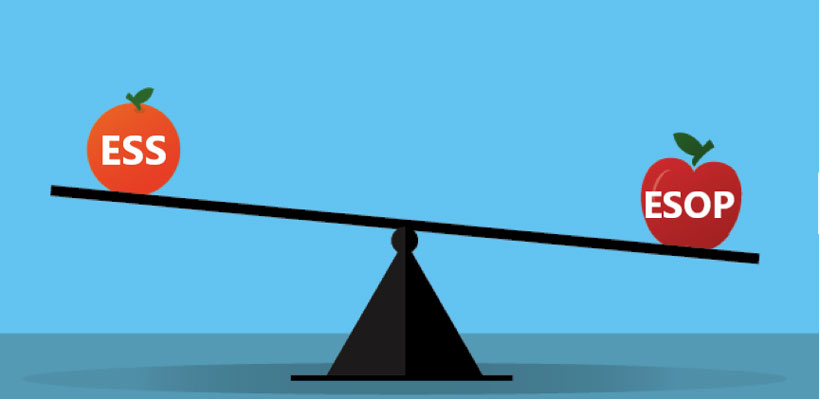Should a Startup Do an ESOP or an ESS for Rewarding Its Employees?
Should a Startup Do an ESOP or an ESS for Rewarding Its Employees?

Is your startup considering granting equity to the employees for promoting their commitments to the startup? If yes, you should know about 02 different schemes to do it which are an employee share scheme (ESS) and an employee share option plan (ESOP).
But which scheme is best for your startup? An ESOP or an ESS? From our practical experience, ESOP is advisable in most cases. This article will address (a) the key differences between an ESOP and an ESS, and (b) why you should use an ESOP instead of an ESS.
What’s the key difference between an ESOP and an ESS?
ESS was initially “invented” to issuing a company’s employee the equity in such a company and therefore enhance the employee’s loyalties to the company business as the employee becomes shareholders of the company after such share issuance.
An ESOP is a kind of “evolved version” of an ESS, in which the company offers its employees options (rights to acquire shares). The options are subject to vesting requirements and rules, which mean that the employee can only convert their options into equity if she/he complies with the rules of the ESOP (e.g., he/she is still the company’s employee as of the conversion date.)
In short, the key difference between an ESOP and an ESS is as follows:
- Under an ESS, the employee is issued shares upfront.
- Under an ESOP, the employee is only granted options (rights to acquire shares), which later can be converted into shares once they have satisfied their vesting conditions.
Why should your startup do an ESOP rather than an ESS?
In practice, most small and start-up businesses have used ESOPs instead of ESSs as ESOPs are often easier to set up and manage. Below are the reasons why ESOPs are more preferable for your startup.
No need for share buy-backs where vesting is not satisfied
Under an ESS, the employees are issued shares up-front, that are subject to vesting requirements (for example, the employee must stick around for a certain period to earn a certain amount of those shares). If the employee does not satisfy the vesting requirements for certain shares, then the company will need to buy back those ‘unvested’ shares.
However, in practice, this buying-back can get quite messy if too many employees cannot satisfy vesting requirements. For example, a company offers shares under an ESS to 30 employees, and only 5 of those employees fully satisfy the vesting requirements, then the company would be required to conduct share buy-backs for the remaining 25 employees where the vesting criteria were not met.
ESOPs can recycle lapsed options
Under an ESOP, where an employee does not meet the vesting requirements, the options will simply lapse. The lapsed options can then be recycled into the company’s option pool to be used for future ESOP offers.
Clearer dilution figures
Under an ESS, as shares are issued up-front, the cap table is updated with the shares issued. When your startup is preparing for a capital raise, this can cause some confusion for potential investors.
For example, determining which shareholders have shares subject to the company’s buy-backs, and which shareholders own their shares outright, may not be immediately clear.
With ESOP, however, they are displayed in a separate ‘option register’ until they are exercised. This provides potential investors a clear overview of the ownership structure of the company.
No voting or dividend rights until options are exercised
Under an ESS, the employee will become a shareholder, just like any other ordinary shareholder, from the start. This means they will get voting rights and rights to dividends.
Under an ESOP, the employee only gets these rights once their vesting has been satisfied and they have exercised their options. This means they technically need to earn those rights, and only the employees that work hard and stick around will get them. And practically they won’t exercise their options until an exit event.
This can make it easier for the company to move quickly on matters requiring shareholder approval. The company won’t need to get shareholder approval from the small employee shareholders for such matters. A simple and quick internal approving process is always a key advantage that a startup needs to maintain.
No up-front payment required from employees
Under an ESS, the employee will be required to pay the share subscription price up-front. This may cause difficulties for the employees if they do not have enough money to purchase shares upfront.
Under an ESOP, the employee is only required to pay the share price when they exercise (or convert) their options into shares. Normally, they won’t exercise their options until there is a clear motivation to do so. For example, they will exercise when the company is about to go through an exit event.
Having no up-front payment can benefit the employees when the offers are made. All they must do is accept it and focus on their work.
No personal income tax (PIT) collection until ESOP options are exercised
Since ESOP subscribers just receive options to acquire shares (not actual shares), the subscribers will only get income, the surplus between the option price and the market value of converted shares, later when they convert the options into equity.
Therefore, there is no ground for collecting PIT from the ESOP subscribers until they execute their options.

